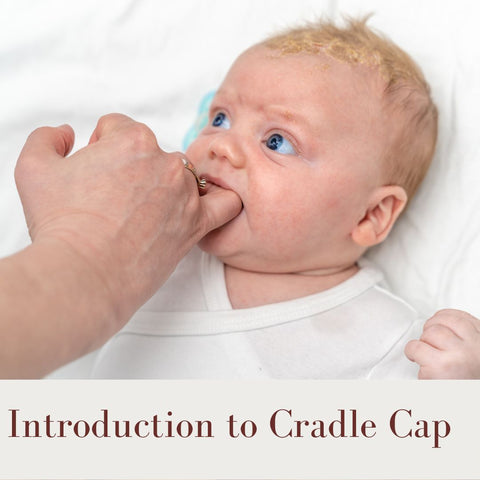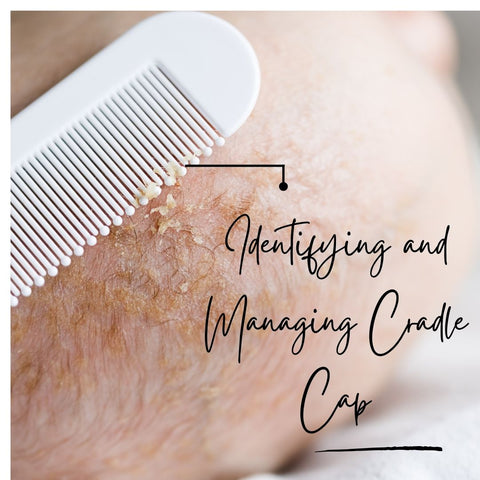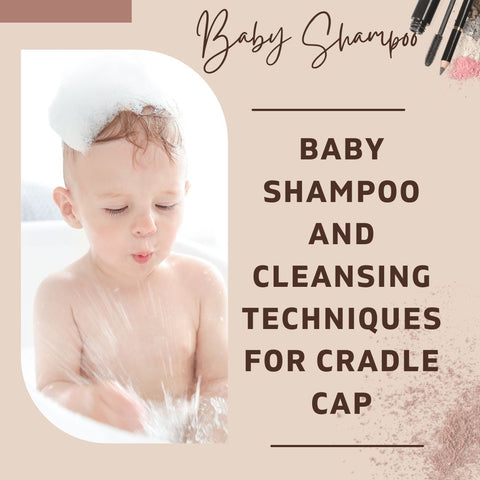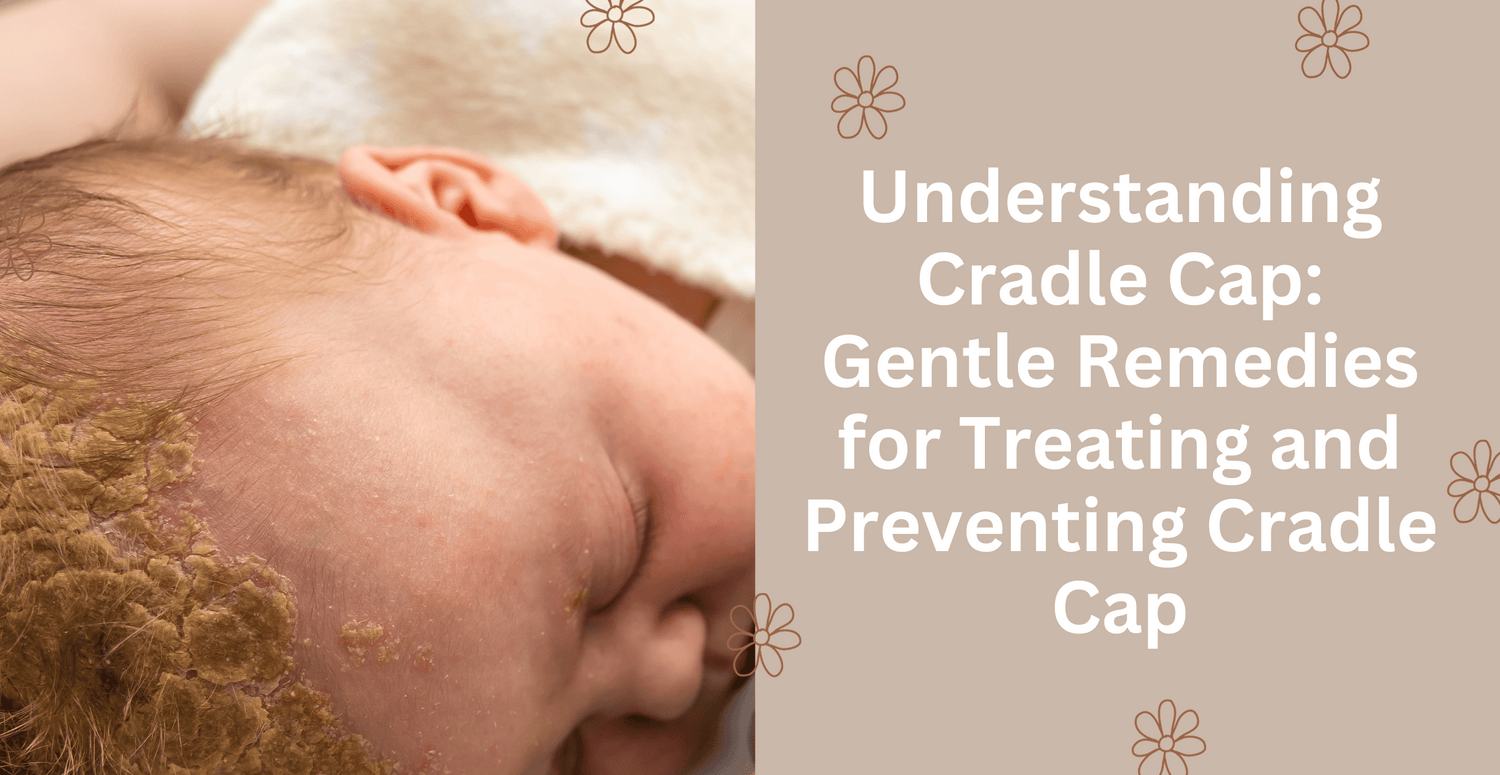Infantile seborrheic dermatitis, known as cradle cap, is a common skin ailment affecting infants. It usually appears as yellowish, oily, scaly patches on a baby's scalp, although it can also be present on other parts of the body. Cradle cap is not contagious, and while it may appear unsightly, it is usually harmless and resolves on its own. This blog discusses some gentle methods for treating and preventing cradle caps.
Introduction to Cradle Cap

Cradle cap, also known as infantile seborrheic dermatitis, is a common skin ailment that commonly affects infants in their first few months of life. The presence of greasy, yellowish, or brownish scales or crusts on an infant's scalp distinguishes it. While it is most commonly found on the scalp, it can also be found on the face, ears, brows, and diaper area. It is vital to emphasise that cradle caps are not communicable and is not caused by improper hygiene. While it is not aesthetically pleasing, it does not usually cause discomfort or irritation in infants.
What is Cradle Cap and Who Does it Affect?
Cradle cap is a harmless, self-limiting skin ailment characterised by greasy, yellow, or brownish scales or crusts on a baby's head. These scales can be thick or thin, and they may have a waxy look at times. While the cradle cap most usually affects the scalp, it can also appear on other parts of the body, including the face, ears, brows, and, in some circumstances, the diaper area. Cradle cap is most common in infants and usually appears within the first few months of life. It is fairly common, and many babies suffer from it to varying degrees. It is more common in newborns and during the first few weeks to months of life, but it can last for a long time in some cases.
Common Causes of Cradle Cap in Babies
Infantile seborrheic dermatitis, sometimes known as cradle cap, is a common skin ailment in neonates. While the specific aetiology of cradle cap is unknown, various factors are thought to contribute to its development, including excessive sebum production, hormonal influence, yeast (malassezia) overgrowth, microbiological causes, environmental factors, and genetic factors. While these characteristics are related to cradle cap, the condition is often harmless and self-limiting. Cradle cap is not contagious, and it is not the result of poor hygiene. The vast majority of cases of cradle cap resolve on their own within a few months to a year.
Identifying and Managing Cradle Cap

Identifying and controlling the cradle caps in your newborn entails recognising the symptoms and taking modest actions to treat them. Here are some critical strategies for identifying and managing cradle cap:
-
Identification: On your baby's scalp, look for yellowish or brownish scales or crusts. These scales may be oily or greasy. In some situations, cradle caps can form on other parts of the body, including the face, ears, brows, and diaper area. It is usually not irritating or unpleasant for the newborn.
-
Gentle Management: Cradle cap is usually self-resolving and does not require aggressive treatment. However, there are some gentle measures you can take to help manage it.
-
Regular Shampooing: Use a moderate, fragrance-free baby shampoo to wash your baby's hair and scalp on a frequent basis. Massage the shampoo into the scalp gently, then thoroughly rinse to remove any residue.
-
Brushing or Combing: Brush your baby's scalp gently with a soft baby brush or a cradle cap brush developed for this purpose. This can assist in loosening and removing the scales. To avoid irritating the skin, be gentle.
-
Apply Oil or Emollient: Apply a tiny amount of natural oil (such as coconut oil or olive oil) on your baby's scalp before shampooing. Allow it to sit for a few minutes to soften the scales before gently brushing or combing them away. When shampooing, make sure to properly rinse the oil off.
-
Avoid Picking or Scratching: The urge to pick at or scratch the scales must be resisted because doing so can irritate them and possibly lead to infection.
-
Medicated Shampoos (if necessary): Your child's paediatrician might suggest a medicated shampoo with active ingredients like salicylic acid or ketoconazole if the cradle cap is severe or persistent. When using medicated products on your baby, always follow the directions provided by your doctor.
-
Monitor and Be Patient: Keep an eye on your baby's cradle cap, and keep in mind that it can take weeks or months to improve. By their first birthday, most babies have outgrown cradle caps.
-
Consult a Pediatrician: If the cradle cap appears to be worsening or spreading, or if you have concerns about your baby's skin, consult your paediatrician. Your paediatrician can give you personalised advice and rule out any other skin conditions.
Symptoms and Appearance of Cradle Cap
Cradle cap is a common cutaneous condition that causes distinct symptoms and looks in neonates. When recognising cradle caps, look for scalp involvement, scaly or greasy patches, an oily or greasy appearance, no itching or discomfort, possible spread to other places, persistence, and the presence of yellow or brownish scales. It's crucial to remember that cradle cap is usually a harmless and self-limiting ailment. It is not contagious and does not result from poor hygiene. While it may not be aesthetically pleasing, particularly when the scales are more prominent, it normally causes no discomfort or injury to the infant. If you believe your infant has a cradle cap, use gentle management methods such as regular bathing with a light baby shampoo, gentle brushing or combing to remove scales, and, if necessary, the application of oils to soften scales before removal. Consult a paediatrician if your infant has persistent or severe cradle cap for additional advice and recommendations customised to your baby's individual needs.
Gentle Ways to Get Rid of Cradle Cap
To avoid irritation and discomfort, cradle caps are routinely removed from infants using gentle and non-invasive methods. Regular shampooing, gentle brushing or combing, applying natural oils, using a fine-toothed comb or warm compress, avoiding picking or scratching, medicated shampoos (if necessary), maintaining good hygiene, being patient, and consulting a paediatrician are some gentle ways to manage and reduce cradle caps. The goal of treatment is to control it gently while keeping your child comfortable. Most newborns overcome the cradle cap with patience and adequate care, and it usually has no long-term repercussions on the scalp or skin.
Natural Remedies for Treating Cradle Cap
Natural treatments for cradle caps in infants can be beneficial. Without the use of harsh chemicals or pharmaceuticals, these gentle ways can help alleviate the problem. Consider the following natural remedies:
-
Coconut Oil: Coconut oil is a popular and natural cradle cap treatment. Apply a tiny amount of coconut oil on your baby's scalp, paying special attention to the problematic areas. Allow it to sit for 15-30 minutes to soften the scales before gently brushing or combing them away. After that, use a mild baby shampoo to eliminate any remaining oil from your baby's hair.
-
Olive Oil: Olive oil is another natural oil that can help soften and remove cradle cap scales. Apply a tiny amount to the afflicted regions, leave it on for a few minutes, and then gently brush or comb the scales away. Use a mild shampoo after that.
-
Almond Oil: Almond oil can also be used instead of coconut or olive oil. Apply a small amount, let it stay for a few minutes, and then carefully remove the scales.
-
Avocado Oil: Avocado oil is high in nutrients and can help keep the scalp moisturised. Apply a tiny amount to the afflicted regions, wait a few minutes, and then gently brush or comb away the scales.
-
Aloe Vera Gel: Aloe vera offers moisturising and calming effects. To treat cradle cap, apply a tiny amount of pure aloe vera gel to your baby's scalp. Allow it to sit for a few minutes before carefully removing the scales.
-
Jojoba Oil: Jojoba oil is mild on the skin and closely matches the skin's natural oils. Apply a tiny amount to the afflicted regions, let it stay for a few minutes, and then gently brush or comb away the scales.
-
Breast Milk: A few drops of breast milk on your baby's scalp can help moisturise and soothe the skin if you are breastfeeding. You can leave it on for a few minutes before gently brushing or combing the scales away.
-
Gentle Shampoo: Wash your baby's hair and scalp on a regular basis with a mild, fragrance-free baby shampoo. Rinse your hair thoroughly after giving it a gentle massage with the shampoo.
-
Warm Compress: You can apply a warm, damp washcloth to your baby's scalp for a few minutes prior to shampooing. This can soften the scales and make them easier to remove.
-
Brushing or combing: Gently brush or comb your baby's scalp in a circular motion with a soft baby brush or cradle cap brush. Avoid irritating or scabbing the skin in any way.
Baby Shampoo and Cleansing Techniques for Cradle Cap

When dealing with the cradle caps in your infant, the baby shampoo you use and the cleansing practises you utilise are critical to managing the problem gently and efficiently. Here are some suggestions for choosing the best baby shampoo and cleaning techniques:
Selecting the Right Baby Shampoo:
-
Choose a Mild, Fragrance-Free Shampoo: Look for a baby shampoo that has been specially formulated to be gentle on a baby's delicate skin. It should be free of strong fragrances and harsh chemicals that could irritate the scalp. Hypoallergenic shampoos are frequently a good option.
-
pH-Balanced Shampoo: Choose a pH-balanced shampoo to help maintain your baby's skin's natural acidity, which is important for skin health.
-
Tear-Free Formulation: Tear-free baby shampoos are designed to reduce eye irritation if the shampoo comes into contact with your baby's eyes during the bath.
-
No Harsh Ingredients: Check the ingredient list for harsh ingredients such as sulphates, parabens, and artificial colors. These additives may irritate sensitive skin.
-
Consult Your Paediatrician: If your baby has specific skin sensitivities or conditions, consult your paediatrician for shampoo recommendations.
Cleansing Techniques for Cradle Cap:
-
Preparation: Use warm water to wet your baby's hair and scalp before applying shampoo. Using a soft towel, gently pat the area dry, leaving the scalp slightly damp.
-
Gently Massage: Use your fingertips to apply a small amount of the selected baby shampoo to the scalp of your infant. Gently massage the skin in a circular motion, being careful not to press too hard or scratch it.
-
Rinse thoroughly: After massaging the shampoo into your baby's scalp, thoroughly rinse with warm water. Make sure to remove all shampoo residue, as any remaining shampoo can contribute to the cradle cap.
-
Brushing or combing: After rinsing, gently brush or comb your baby's scalp in a circular motion with a soft baby brush or cradle cap brush. This can assist in loosening and removing scales.
-
Avoid Scratching or Picking: Avoid scratching or picking at the scales as this can cause irritation and infection.
-
Repeat as Needed: Depending on the severity of the cradle cap, you may need to repeat the shampooing and brushing process on a regular basis until the condition improves.
-
Apply Natural Oils (Optional): Before shampooing, massage a natural oil like coconut oil or olive oil into your baby's scalp to soften the scales. Allow a few minutes to pass before shampooing.
-
Consult Your Paediatrician: If the cradle cap persists or worsens despite gentle cleansing, seek further advice and recommendations from your paediatrician.
Moisturizing and Nourishing the Scalp
Moisturising and nourishing the scalp is vital for maintaining healthy skin, and it can be especially helpful in treating issues like cradle caps in babies. Use a gentle, baby-safe moisturiser, apply moisturiser after bath time, use natural oils, avoid overuse of oils, consider baby shampoos with added moisturisers, maintain good hydration, protect from harsh weather, monitor and be consistent, and consult your paediatrician for more information. Keep in mind that a cradle cap is usually a brief and innocuous condition. Proper scalp moisturization and nourishment, as well as mild washing, practises, can help manage the cradle cap and maintain general skin health in your infant.
Brushing and Gently Removing Cradle Cap Flakes
Brushing and gently removing cradle cap flakes is a crucial aspect of keeping your infant comfortable while controlling the condition. Here's how to do it properly and safely:
-
Gather Your Supplies: A soft baby brush or cradle cap brush will be required. Make sure the brush is clean and clear of debris.
-
Prepare the Scalp: Make sure your baby's scalp is clean and slightly damp before brushing. This can be accomplished by cleaning your baby's hair with a gentle baby shampoo during their bath. Rinse completely and massage the scalp dry softly with a soft towel.
-
Be Gentle: Use delicate, slow strokes while holding the brush lightly but firmly. You don't want to scratch or irritate the baby's fragile scalp, so avoid using too much force or pressure. Be nice and patient. Cradle cap flakes can be difficult to remove, and it may take some time.
-
Brush in a Circular Motion: Gently lift and remove the flakes with the brush in a circular motion. Start at the edges of the affected area and work your way towards the centre. Avoid brushing against the natural direction of hair growth, as this can be uncomfortable for your baby.
-
Avoid Picking or Scraping: Never pick or scrape at the flakes with your fingernails or other sharp objects. This can cause skin damage and possibly infection.
-
Comb if Necessary: In addition to brushing, a fine-toothed comb designed specifically for cradle caps can be used. Comb gently and only when necessary to help lift and remove stubborn flakes.
-
Repeat as Necessary: Depending on the severity of the cradle cap, you may need to repeat the brushing and combing process on a regular basis to effectively manage the condition.
-
Follow with Moisturizing (if desired): After brushing and removing the flakes, massage the scalp with a gentle, baby-safe moisturiser or natural oil. This can help keep the skin hydrated and prevent further dryness.
-
Rinse and Clean the Brush: After each use, thoroughly rinse the brush to remove any scales and debris. Keeping the brush clean is critical to preventing the spread of any potential irritants.
-
Be Consistent and Patient: When it comes to cradle caps, consistency is everything. It may take several weeks to months for the condition to fully improve, so be patient and stick to a gentle routine.
-
Consult Your Pediatrician: If your baby's cradle cap persists or worsens despite your efforts, seek professional advice and recommendations from your paediatrician.
By using these gentle brushing and flake removal techniques, you can effectively manage the cradle cap while ensuring your baby's comfort and skin health.
Prevention Tips for Cradle Cap in Infants
While the cradle cap is normally innocuous and disappears on its own, you can take some precautions to limit the risk of its onset or severity. Regular scalp hygiene, gentle brushing, maintaining good skin hydration, avoiding harsh products, avoiding overuse of oils, maintaining a consistent bathing routine, rinsing thoroughly, protecting from cold weather, a balanced diet for breastfeeding moms, consulting a paediatrician, and being patient are some prevention tips for infant cradle caps. You may help lessen the likelihood of a cradle cap and maintain general skin health for your infant by following these prevention tips. If the cradle cap does form, rest assured that it is a common and harmless ailment that usually disappears with loving care and patience.
Long-Term Effects and Duration of Cradle Cap
Cradle cap is generally a temporary and benign condition that typically does not have long-term effects on a child's health or scalp. It is considered a mild and self-limiting skin issue that tends to resolve on its own over time. Here are some key points regarding the duration and long-term effects of cradle caps:
-
Duration: Cradle cap often appears within the first few weeks of a baby's life, usually within the first few months. It can last several weeks or months. As the baby's skin matures, most cases of cradle caps improve and eventually resolve on their own.
-
Long-Term Effects: Cradle cap is generally regarded as a harmless condition that has no long-term effects on a child's health. It causes no hair loss or permanent scalp damage. There is no evidence that cradle cap is linked to any other health or developmental issues.
While cradle cap does not have long-term consequences, it is critical to manage it gently and effectively while it is present in order to keep the baby comfortable and maintain good skin health. An untreated cradle cap can cause mild discomfort or localised irritation, but this is usually manageable with proper care. If cradle cap persists after a baby's first year or if there are concerns about the health or appearance of the scalp, it is best to seek advice from a paediatrician or healthcare professional. They can assess the situation, make recommendations for further care or treatment, and ensure that no underlying issues are causing the condition.
Cradle Cap vs. Dandruff: Understanding the Difference
Cradle cap and dandruff are both common scalp illnesses characterised by the presence of flakes or scales, but their etiology, age of onset, appearance, and therapy differ. Here's a comparison to help you understand the differences between cradle cap and dandruff, including age of onset, causes, appearance, location, irritation and pain, and therapy. If you are unsure about the disease affecting your or your child's scalp, or if you have any concerns, consult a healthcare professional or dermatologist for a definitive diagnosis and treatment suggestions.
When to Seek Medical Advice for Cradle Cap

Cradle cap is typically a harmless, self-limiting ailment that improves on its own over time. However, in some cases, such as persistent or worsening symptoms, secondary infections, excessive itching or discomfort, spread to other areas, concerns about skin health, discomfort during hair washing, and failure to improve by the first birthday, it is best to seek medical advice or consult a paediatrician for guidance and evaluation. However, if you have any reservations or worries, or if the condition appears uncommon or serious, seeing a healthcare professional is a wise step to safeguard your baby's safety and to receive expert advice on the best course of action.
Consulting a Pediatrician for Severe or Persistent Cradle Cap
Consultation with a paediatrician for a severe or persistent cradle cap is a responsible and suitable action to safeguard your baby's skin health and to obtain expert advice on the disease. The severity of the cradle cap, lack of improvement, other afflicted regions, evidence of infection, itchiness or pain, worries about skin health, discomfort while hair washing, and age beyond one year are all reasons to consult a paediatrician. Seeking their assistance is a proactive step towards ensuring your baby's comfort and well-being, and they may provide personalised recommendations customised to your baby's individual needs.
Do's and Don'ts for Managing Cradle Cap
Managing cradle cap in infants necessitates gentle and consistent care. Here are some dos and don'ts to help you effectively manage cradle cap:
Do's:
-
Do Use a Mild Baby Shampoo: To wash your baby's hair and scalp, use a mild, fragrance-free baby shampoo. A gentle shampoo can help to avoid irritation.
-
Do Thoroughly Rinse: After shampooing, thoroughly rinse your baby's scalp to remove all shampoo residue. Cradle cap can be exacerbated by leftover shampoo.
-
Brush Gently: Using a soft baby brush or a cradle cap brush, gently brush your baby's scalp in a circular motion. This can aid in the loosening and removal of scales.
-
Apply Natural Oils (if desired): To soften scales, apply a small amount of natural oil such as coconut oil, olive oil, or almond oil to your baby's scalp before shampooing.
-
Do Use a Fine-Toothed Comb (if Necessary): If stubborn scales persist, use a fine-toothed comb designed specifically for cradle cap. Lift and remove scales with a gentle comb.
-
Do Keep Your Baby's Scalp Clean and Dry: Keep your baby's scalp clean and dry. Cradle cap is less likely to form on a clean scalp.
-
Do Be Consistent: Maintain a regular scalp care routine, even if the results are gradual. Consistency in care is essential for effectively managing cradle cap.
-
Consult a Paediatrician if Needed: If you have any concerns, or if the cradle cap is severe, persists, or worsens, seek professional advice and recommendations from your paediatrician.
Don'ts:
-
Do not Scratch or Pick: Avoid scratching or picking at the scales as this can cause irritation, infection, and worsen the condition.
-
Don't Use Adult Shampoos or Harsh Products: Adult shampoos and hair products should not be used on your baby's scalp because they contain harsh chemicals and fragrances that can irritate the skin.
-
Avoid Excessive Oils: While natural oils can be beneficial, excessive oil on the scalp can contribute to cradle cap. Use oils sparingly and thoroughly wash them out during the next bath.
-
Do not Over-Bathe: Avoid over-bathing your baby, as this can strip the skin of natural oils and aggravate dryness.
-
Do not worry: cradle cap is a common and temporary condition. While it may not be visually appealing, it usually causes no discomfort or harm to the baby. Be patient and avoid unnecessary worry.
-
Consultation Should Not Be Delayed If Required: If you have any questions or concerns about the condition or the comfort of your baby, contact a healthcare provider right away. Early intervention can help to avoid complications.
Remember that cradle cap is usually only temporary and is easily treated. You can successfully treat cradle caps while maintaining the comfort and health of your baby's scalp by observing these dos and don'ts.
Importance of Gentle Care for Baby's Delicate Scalp
Gentle care for a baby's delicate scalp is essential for several reasons, including protecting sensitive skin, minimising discomfort, preventing damage, maintaining skin health, avoiding allergies and irritation, promoting bonding, encouraging good hygiene, preventing cradle cap, supporting healthy hair growth, and promoting emotional well-being. Care for a baby's fragile scalp is critical for safeguarding sensitive skin, maintaining overall skin health, reducing pain, and promoting a positive bonding experience between carers and babies. It is a fundamental part of caring for an infant's well-being and should be continuously practised.















